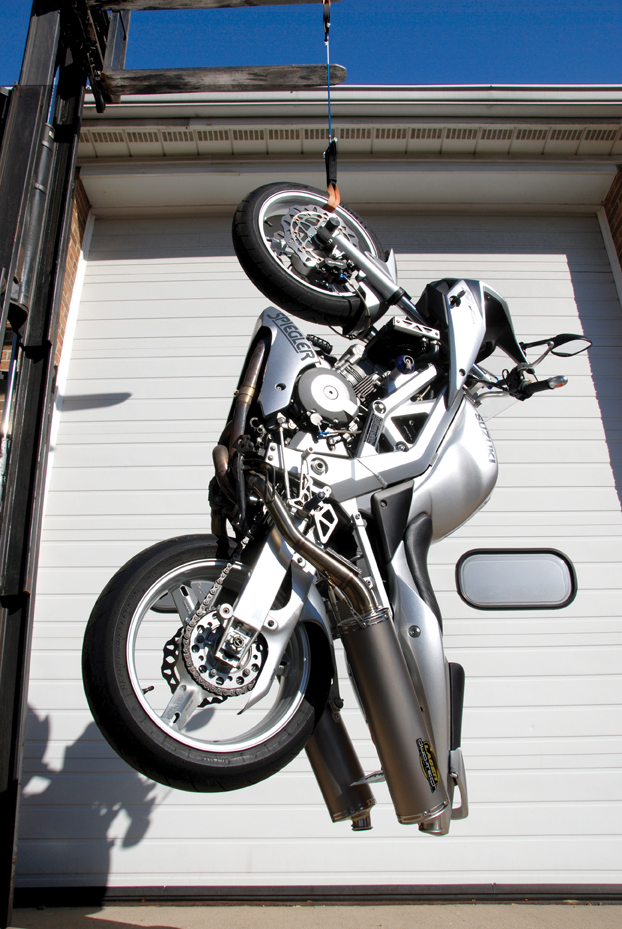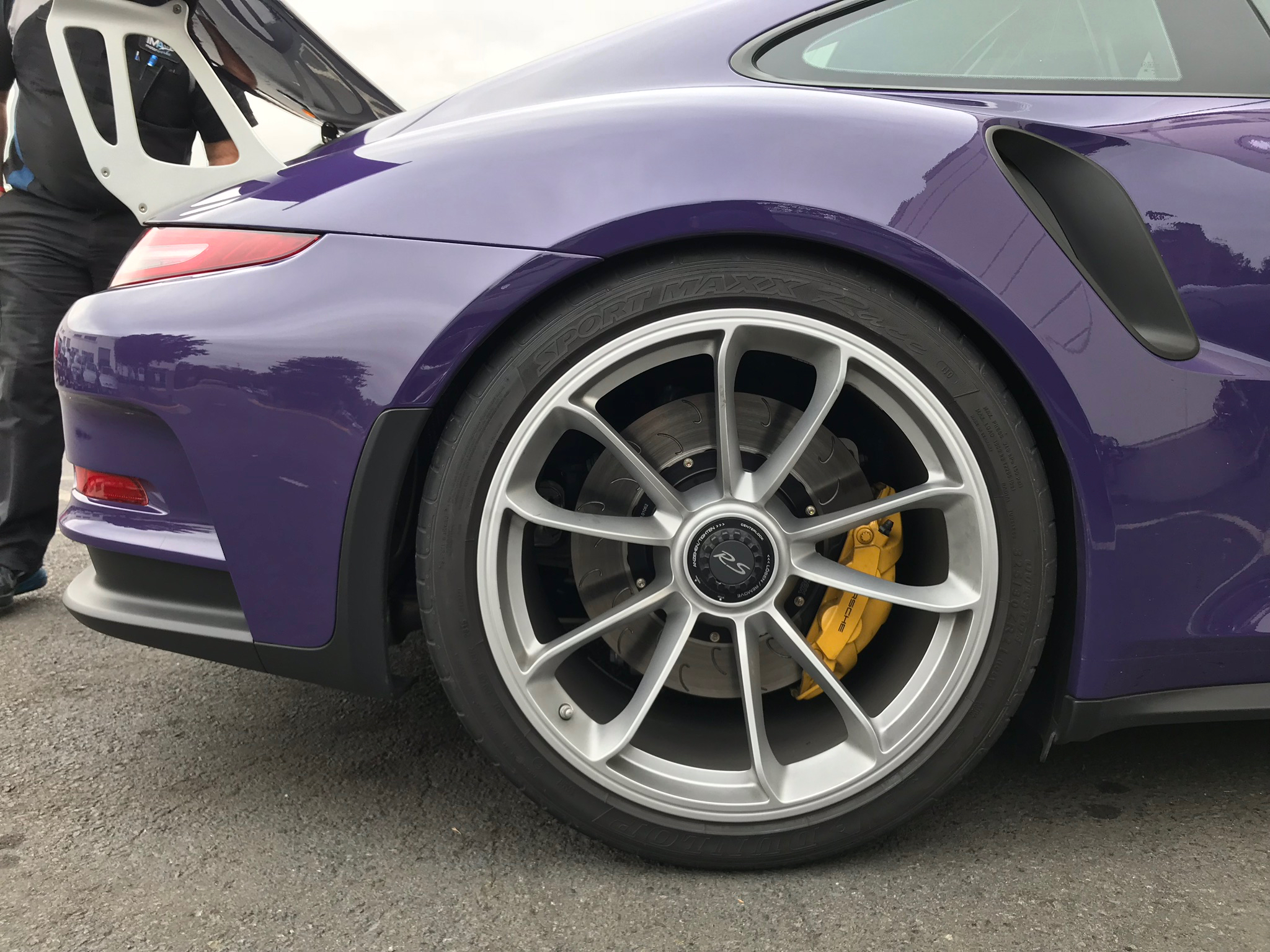
Part #: 13.01.40007
Brand: Essex & AP Racing
Take your first step towards a track-capable brake system by maximizing your OEM brake calipers' performance on the road or track. AP Racing by Essex 2-piece J Hook Brake Discs, Ferodo Racing Pads, and Spiegler SS Lines, all in one box at an attractive price!
- All components bolt-on with OEM PCCB rear calipers, no modifications required
- Uses the standard rear 991 GT3/RS pad shape used in OEM iron system
- Improved pad and fluid fade resistance, enhanced feel, ultra lightweight, and dramatically increases brake longevity under repeated track sessions
- Features AP Racing by Essex 2-piece Competition J Hook Discs in the OEM rear size
- 15.35" x 1.26" (390mm x 32mm) 72 Vane, D66 radial depth
- Huge increase in airflow, cooling capacity, and durability vs. OEM discs
- Discs weigh approximately the same as OEM 380 x 34mm units, despite larger size
- Ultralight, fully floating, anodized billet aluminum hat with float control/anti-rattle clips
- Designed for: club racing, time trial, autocross, HPDE
- Also includes Porsche-specific Spiegler Stainless Brake Lines, two bottles of AP Racing R3 Brake Fluid, and front Ferodo Racing brake pads in the compound of your choice
WHICH FERODO PAD COMPOUND IS RIGHT FOR YOU? CLICK HERE FOR A DETAILED COMPARISON ARTICLE
CLICK HERE TO LEARN MORE ABOUT OUR PATENTED DISC BURNISHING PROCESS
Fits: Rear ( Porsche 991 GT3, GT3RS GT4RS with PCCB)
WHAT'S IN THE BOX?
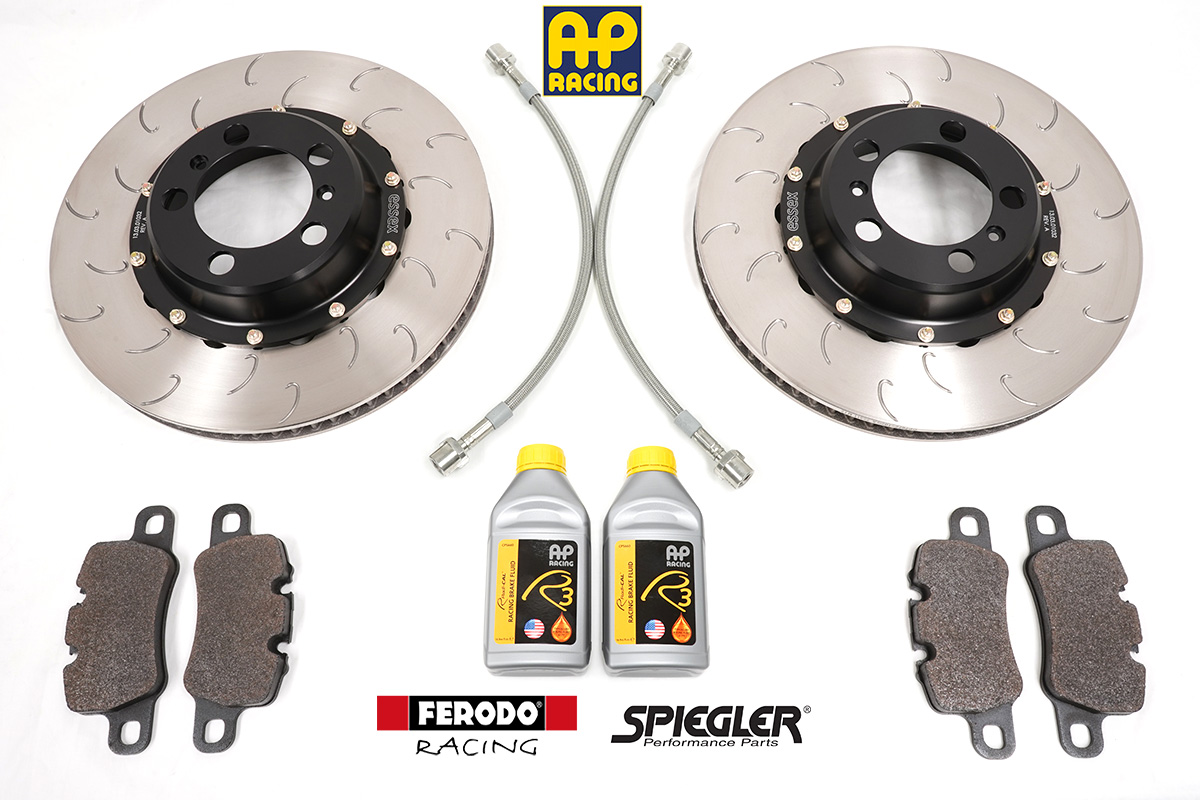
- One pair of 390mm x 32mm AP Racing 72-vane J Hook racing discs, with fully floating 6061 hard anodized aluminum hats and attachment hardware
- One pair of Spiegler Stainless Steel Brake Lines with abrasion resistant coating, installation hardware
- Two bottles of AP Racing R3 Brake Fluid (617°F dry boiling point)
- One rear axle set of Ferodo Racing FCP4665 Brake Pads in DS3.12, DS1.11, or DS2500 compound (Pad Compound Comparison)
AP Racing J Hook Discs are the epitome of endurance racing components. They will hold up extremely well to any abuse you plan to throw at them. These discs have been proven time and again in professional racing, winning many races and championships (ALMS, Rolex, Grand Am, etc.).
Iron vs. Carbon Ceramic Brake Discs
In the past few years, Carbon Ceramic brake discs have become increasingly popular on high-end sports cars as either standard equipment or as a factory installed option. Although expensive, they're a great choice for a car that is used exclusively on the street. They save a large amount of unsprung weight, they don't generate much brake dust, have low NVH, and they may even last longer than the rest of the car! For the avid track enthusiast however, they're typically not the best choice.
On the racetrack, repetitive stops from high speeds generate considerably higher brake disc temperatures vs. what could ever be legally or sanely achieved on the street. Various manufacturers producing the current crop of carbon ceramic discs claim to match iron disc durability on the track, but our experience tells us otherwise. While they may be less resistant to warping or deformation at repeated elevated temperatures, the biggest problem with carbon ceramic discs is that they tend to oxidize at track temperatures, showing rough surface eruptions on the disc face. In some cases the oxidation is terminal (chopped fiber discs), and the discs must be scrapped once it occurs. In other cases (continuous fiber discs), the discs can be resurfaced, but only a limited number of times and at a high cost. Most carbon ceramic discs are measured in terms of minimum mass, rather than the traditional minimum thickness used to measure iron discs. Once the minimum mass is reached, the carbon ceramic disc is trash.
Below is an oxidized carbon ceramic disc. Notice the dark spots in which the surface is flaking off / eroding. When your disc looks like this, it has become a $2,000 paperweight!

Other Potential Pitfalls with Carbon Ceramic Discs:
- Low airflow- If you look at a specific car model that offers both iron and carbon ceramic discs as an option, the carbon ceramic discs will almost always be considerably larger in overall dimension, with a specific emphasis on a tall radial depth (distance from outer disc edge to inner disc edge). Whereas an iron disc uses a web of directional internal vanes to speed airflow through the disc, most carbon ceramic discs rely primarily on their large surface area to radiate heat into the air surrounding the disc. Hence, the tall radial depth.
- Expensive and limited range of compatible brake pads- There aren't many brake pad options with carbon ceramic discs. The pads must be compatible with the specific disc material being used, and if they aren't, they can destroy the discs in a hurry. Since brake pads are a very personal choice to most track junkies, carbon ceramic discs don't provide many options for the driver to chase a desired feel. Also as noted above, carbon ceramic discs tend to be very tall radially, which means very large brake pads are required. In the world of brake pads, price is usually directly proportional to size: Bigger = more expensive.
- Poor feel- Experienced drivers will tell you that cast iron discs provide superior pedal feel due to less compress-ability. Some drivers find that carbon ceramic discs feel soft or abrasive at lower temperatures, but feel like stone with little modulation once they heat up. Feel and the resulting confidence is rather important when hurtling towards a guardrail at 150mph!
- High replacement disc cost- Carbon ceramic replacement discs can be hideously expensive. If you do wear out or damage a disc, it can cost thousands of dollars to replace each one. When running carbon ceramic discs hard on a racetrack, the odds of having to replace one or more of them increases exponentially vs. if you only drive your car on the street.
- Damage-prone- Many manufactures suggest covering their carbon ceramic discs when handling them, so they are not chipped or fractured. One knock when changing a wheel can destroy a disc. Additionally, some chemical wheel cleaners or abrasives used in car detailing can damage carbon ceramic discs.
- Splinters- Carbon ceramic discs shouldn't be handled with bare hands, as they can leave carbon splinters in the skin.
- Greater sensitivity to burnishing/bedding-in- Most manufacturers have an explicit, and sometimes intricate, set of instructions for bedding-in their carbon ceramic discs. Iron discs can typically be prepared via a simple series of stops from 60-80 mph with the brake pad of choice.
Carbon Ceramic is NOT Carbon/Carbon
At this stage you may be saying to yourself, "But I saw that the XYZ professional race cars were running carbon brakes at the track." The carbon brakes currently being used in professional racing are carbon/carbon (abbreviated C/C), which is actually a different material vs. the carbon ceramic discs used on road cars. The carbon ceramic brake discs on road cars are a Carbon Ceramic Matrix (CCM). In recent times many professional racing series (F1, ALMS, IRL, etc.) have switched to carbon/carbon brake discs in an effort to reduce weight. Carbon/Carbon is an outstanding lightweight material for racing, but requires heat before it starts to generate usable friction. As such, they're completely ill-suited to a typical morning commute in a road car!
Iron Disc Benefits
So what can AP Racing J Hook iron discs do for a car previously equipped with carbon ceramic discs?
- Increased airflow and slower heat transfer to other brake components- AP Racing J Hook discs have a unique, high-count vane design that promotes airflow, heat evacuation, and rapid cooling. They don't rely on a large surface area to cool via radiation. The iron discs will move more air than your carbon ceramic's, and as a result they won't heat your brake pads, caliper pistons, and brake fluid up as quickly. You'll be able to run longer sessions without brake fade, and you'll enjoy the confidence that comes along with them. They'll also make any brake ducts that you have on the car more effective and useful.
- Huge range of compatible brake pad compounds- Iron discs will open up a much greater range of available brake pads. You'll be able to achieve a different feel, and tailor your brake setup depending on your needs and environment, whether that is running an AutoX or the most demanding racetrack in your area. You'll also likely be paying less per brake pad set than you were previously, and your pads will last longer.
- Inexpensive spare discs- You'll no longer have to spend thousands of dollars when it's time to replace your discs. AP Racing J Hooks typically cost a fraction of the equivalent-size carbon ceramics, so you won't have to stress about anything happening to them. They're inexpensive enough that you can always keep a spare set on hand, so you won't have to worry about any brake-related downtime when you're out at the track.
- Durability- Iron discs can take a beating. You can stash your spares in your race trailer, and you won't have to worry about handling them, covering them, dinging them, or chipping them when changing your wheels.
As you can see, although iron discs do come with a slight weight penalty, they're still the smart choice if you run your car hard on the racetrack. They're the obvious solution that has been proven countless times on tracks around the world, at all levels of motorsport.
AP Racing J Hook Discs are the epitome of endurance racing components. They will hold up extremely well to any abuse you plan to throw at them. These discs have been proven time and again in professional racing, winning many races and championships (ALMS, Rolex, Grand Am, etc.).
Two-piece Floating Design with Aluminum Hat
As is the case with most metal, iron brake discs grow substantially when heated. As it is heated, a disc expands radially, increasing in diameter and circumference. One-piece disc designs run into problems when this occurs. Look at the picture below and imagine the disc is being heated on the track. As the disc expands, the outer edges of the disc are pulling away from the center of the disc, but there are no built-in provisions to allow for that expansion. The edges of the disc therefore pull, lift, and distort, which is called coning. Now imagine that disc vertical on the car, running in your caliper. Coning directly impacts the brake pads’ contact with the disc, leading to uneven wear and tapering, and even a long brake pedal.
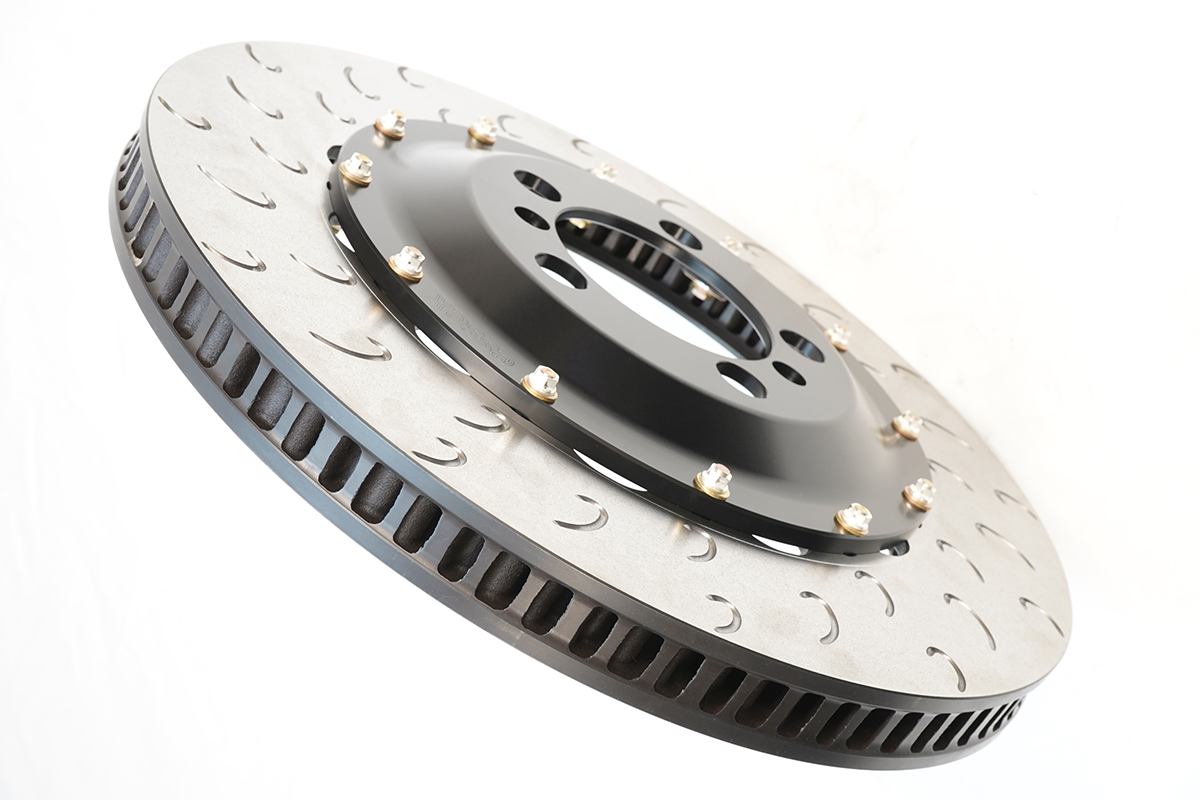
Two-piece discs on the other hand, compensate for the expansion of the disc as it heats. This is accomplished by building ‘float’ into either the disc itself, or the disc hat/bell. In this case, the float is in the disc. If you look closely at the picture below, you can see that the mounting holes for the hat attachment bobbins are not round. They are an oblong shape. These channels allow the hat mounting hardware to slide as the disc is heated and expands, allowing the disc to run true in the caliper without distortion. That means less distortion, stress cracks, and pad taper.

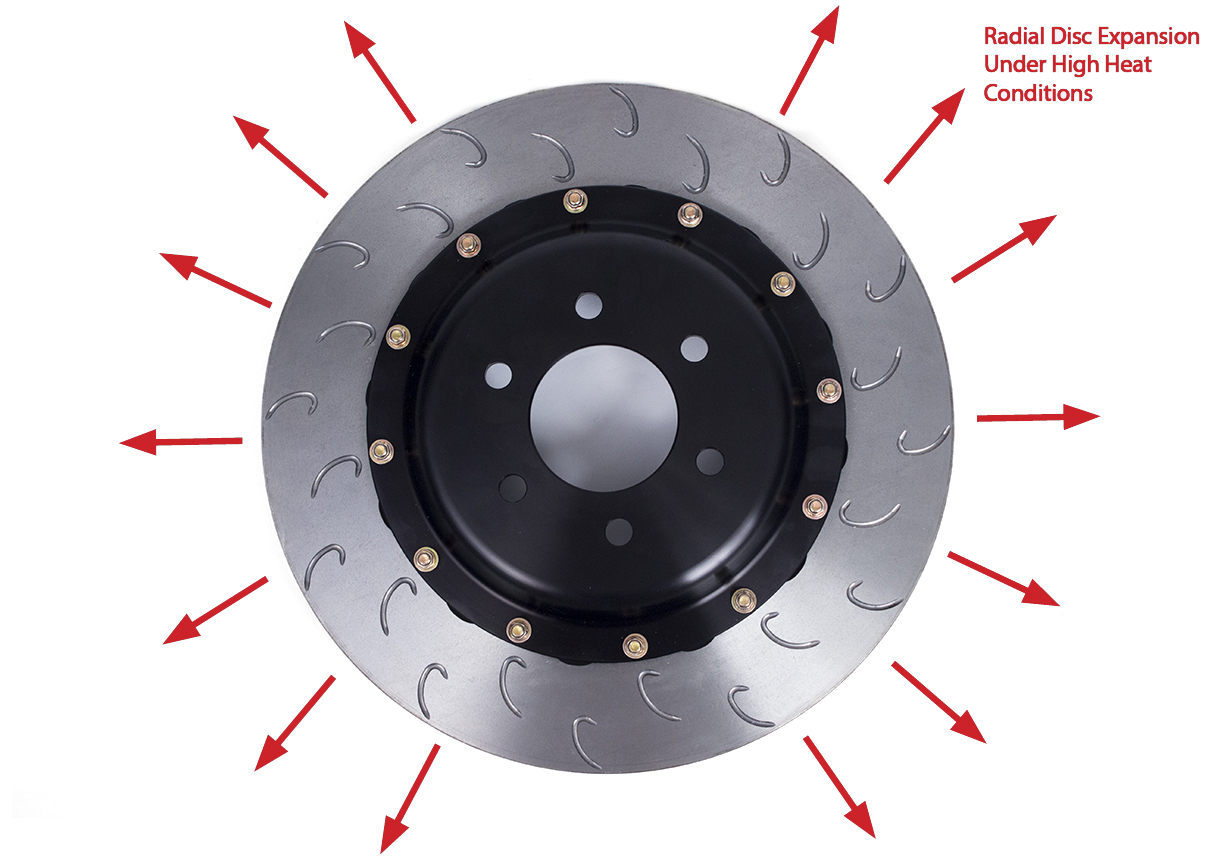

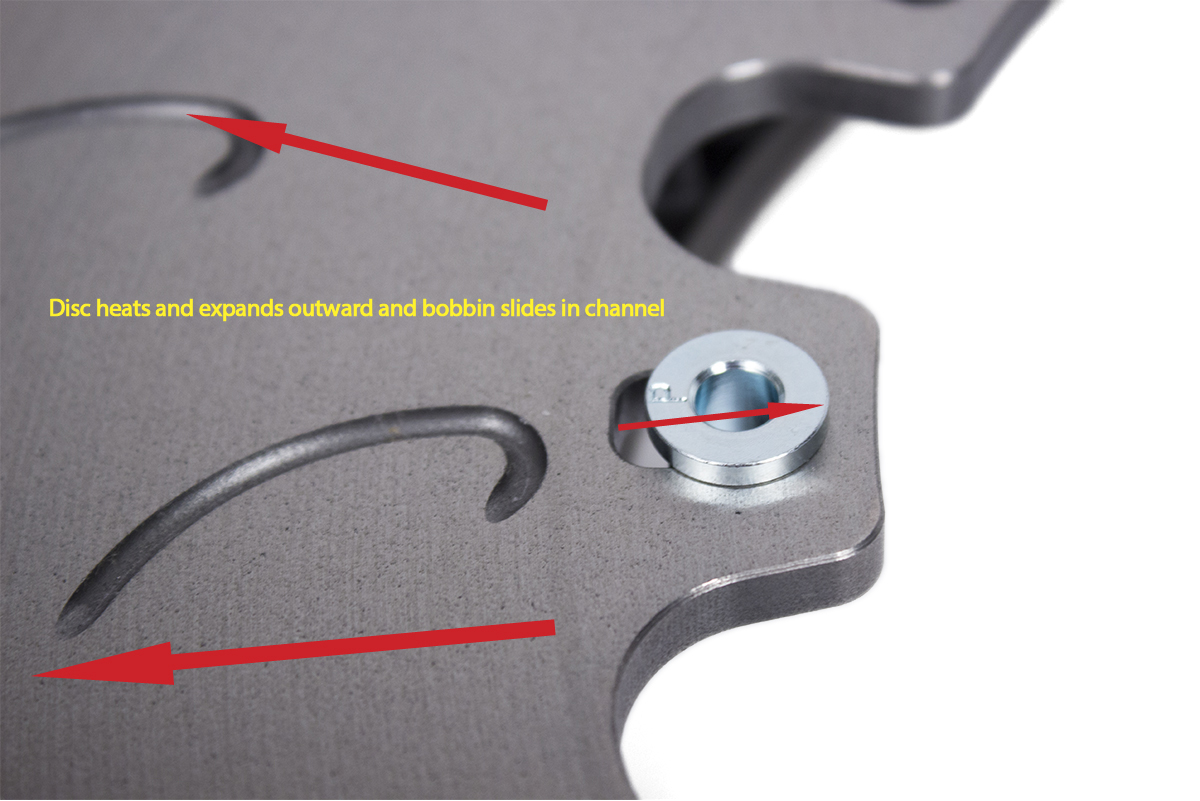
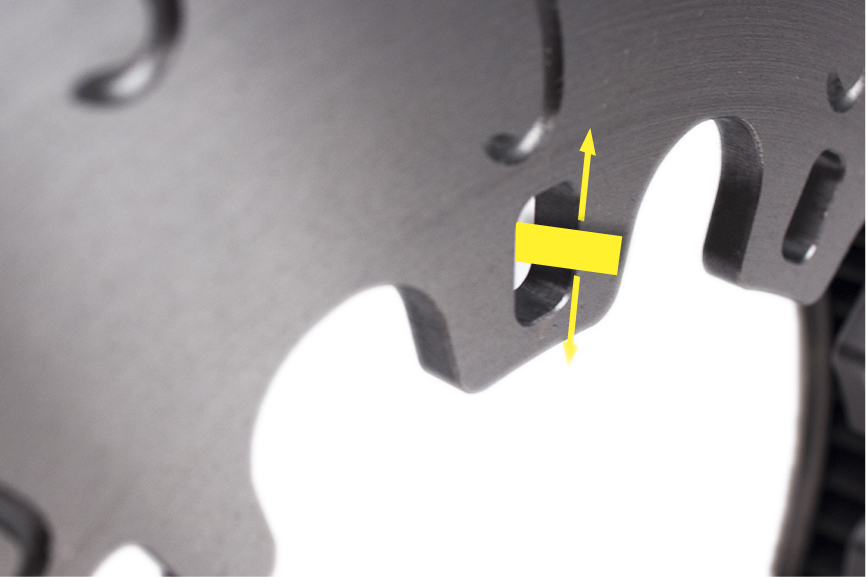
Mounting Hardware and Anti-Knockback Spring Clips
If you look closely at the mounting hardware we use on our Competition Discs, you’ll notice a few details that are often overlooked in lesser products. These components are specially made for their intended purpose. These are not cheap bolts found at your local big box store. They are custom made in the USA for Essex and AP Racing, and they are the exact same components we use on professional racing products.
In order to help control the lateral motion of the disc, which pushes the pistons back into the caliper, we use an anti-knockback spring clip on every other disc attachment point (on a ten bolt disc there are five spring clips, while on a twelve bolt disc there are six). These spring clips help keep the disc hat and iron ring in alignment, while still allowing the disc to expand and float radially. As an added bonus, they prevent the hat and iron disc from rattling and making noise.
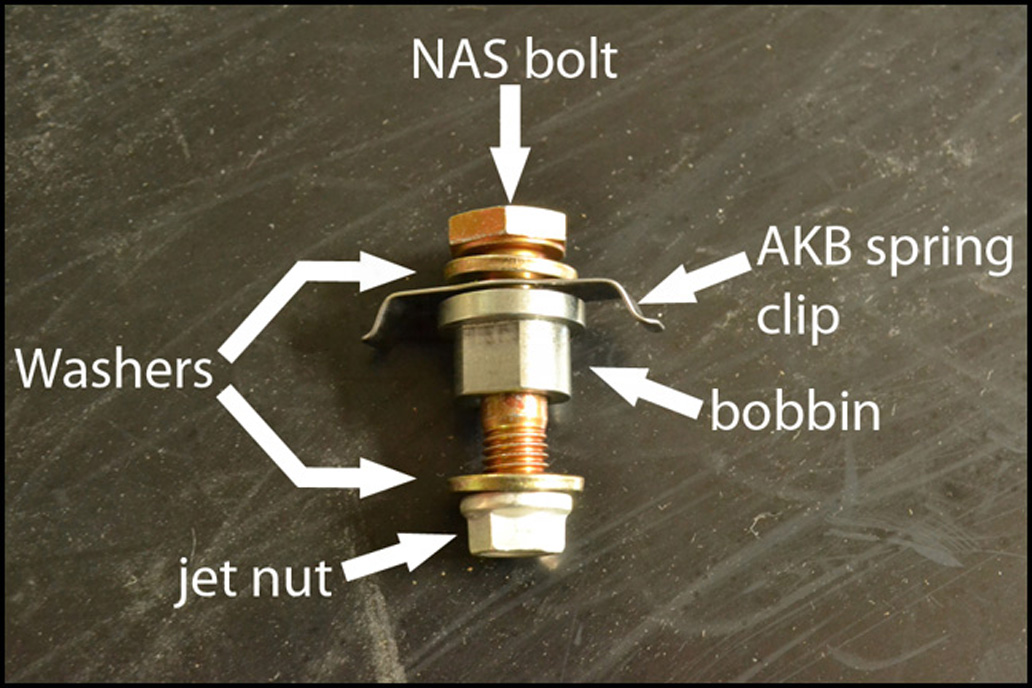
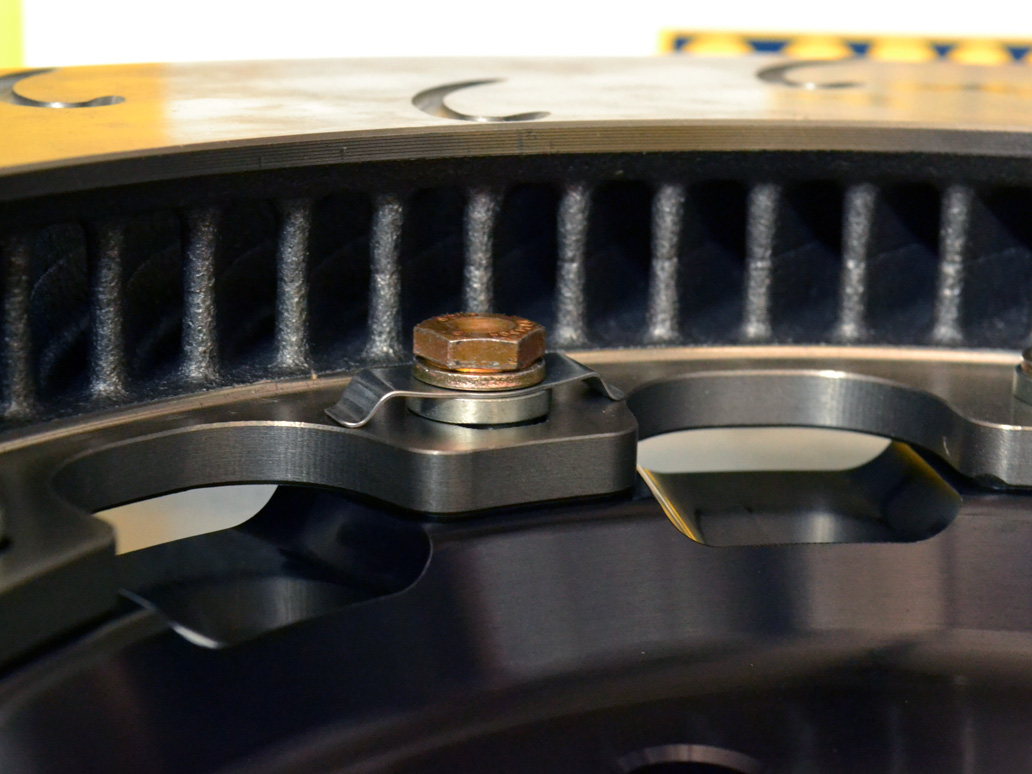
Hat Design
Floating two-piece discs also have the added benefit of reducing heat conduction to the hubs and bearings, decreasing wear and tear on these costly components. The disc hats themselves are manufactured from 6061 heat-treated billet aluminum, with a hard anodized coating. This material was specifically chosen for its strength at high temperatures, as it will be in direct contact with the searing hot iron discs. The hats feature scallops on the underside, to allow for heat evacuation along the outer disc face once installed.
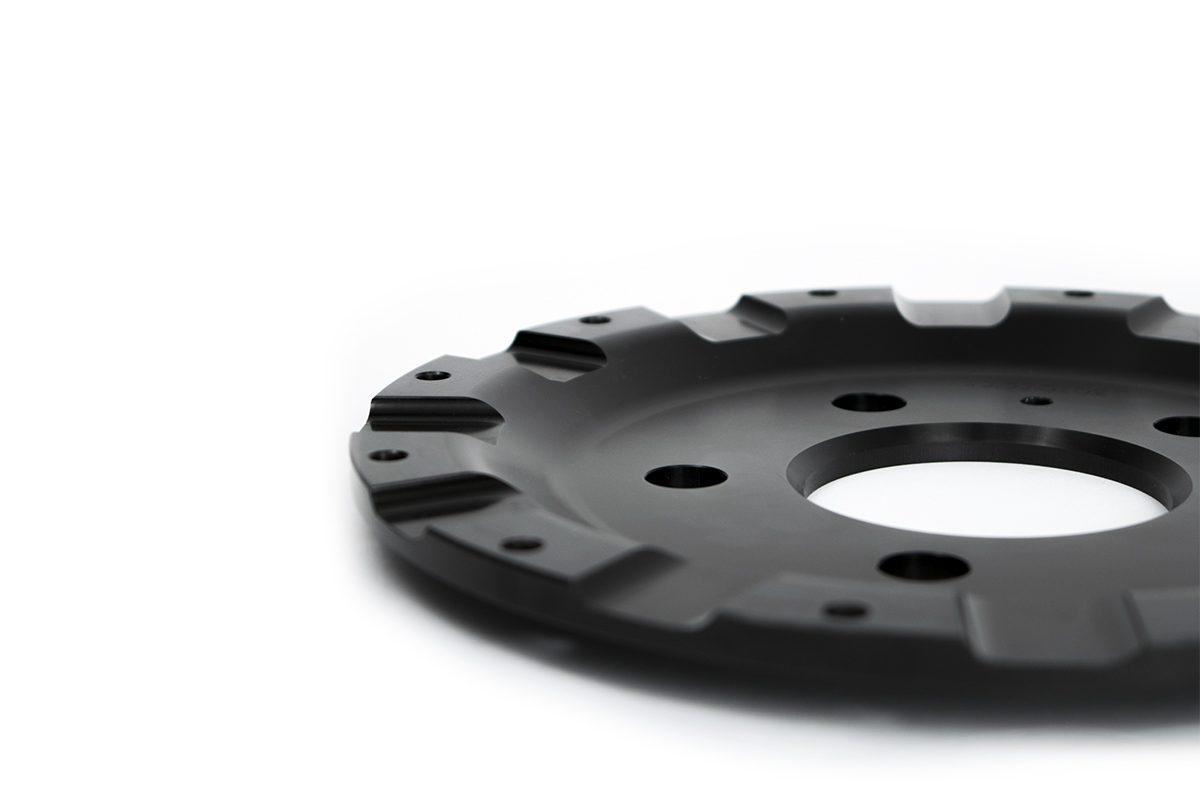
Exclusive AP Racing J Hook Slot Pattern
When you cut a slot or drill a hole in a disc you impact heat transfer. The area around the slot or hole acts as a cool spot when the disc heats up, which is not ideal. Ideally, heat is distributed uniformly around the disc so it can be hit with the cooling air that is pumping through the disc, radiate outwards away from the disc, etc. Cool spots create stress risers and increase the likelihood of the disc cracking. They also cause the face of the disc to distort unevenly, leading to uneven pad deposits, vibration, and judder.
The OEM discs avoid this problem by simply leaving the face blank. While the risk for NVH goes down, so does the pad bite and feel of the disc through the brake pedal. Competitive aftermarket offerings typically have straight slots, which tend to leave cool spots across the disc face between the slots.
During exhaustive R&D testing, AP's J Hook design was found to create a constant pathway of evenly distorted material on the face of the disc. The hooks are spaced out as evenly as possible both around the circumference of the disc, as well as from the inside edge (where the hat attaches) to outer edge, with a slight overlap to promote even heat distribution/distortion. In addition to reducing cracking, the even heating of the disc also helps provide an even transfer layer of pad material on the disc when you bed them in.
Additionally, the J Hook slot pattern produces a greater number of leading edges for the pads to bite into vs. a traditional curved slot pattern, and particularly a plain-faced disc. While this may lead to slightly more whirring or scraping noises from the discs when applying the brakes, the benefits of more even heat distribution, less propensity to crack, cleaner pad material transfer during bed-in, and more bite far outweigh the slight increase in NVH for the serious enthusiast.
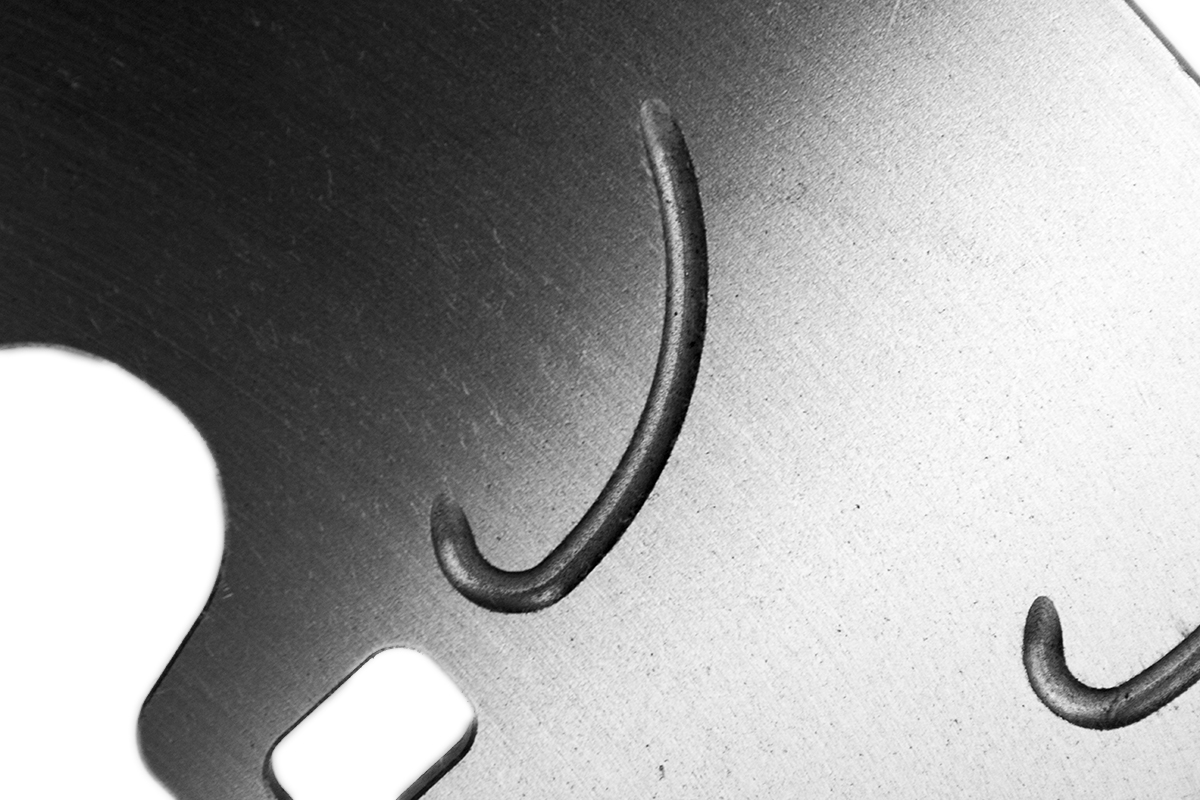
Feature: Complex Metallurgy Developed Through 50+ Years of Experience
AP Racing has been designing brake components for more than 50 years. They've had their components on cars that have won more than 750 Formula 1 races! On any given race weekend, AP J Hook discs can be found on 75% or more of the NASCAR Sprint Cup grid. AP has learned from these experiences, and have developed a proprietary iron alloy with extreme durability, designed specifically for what you intend to do with it (flog the hell out of it). The primary objectives with OEM discs are simple: they must be cheap and easy to produce. The design objectives for these two products are vastly different.
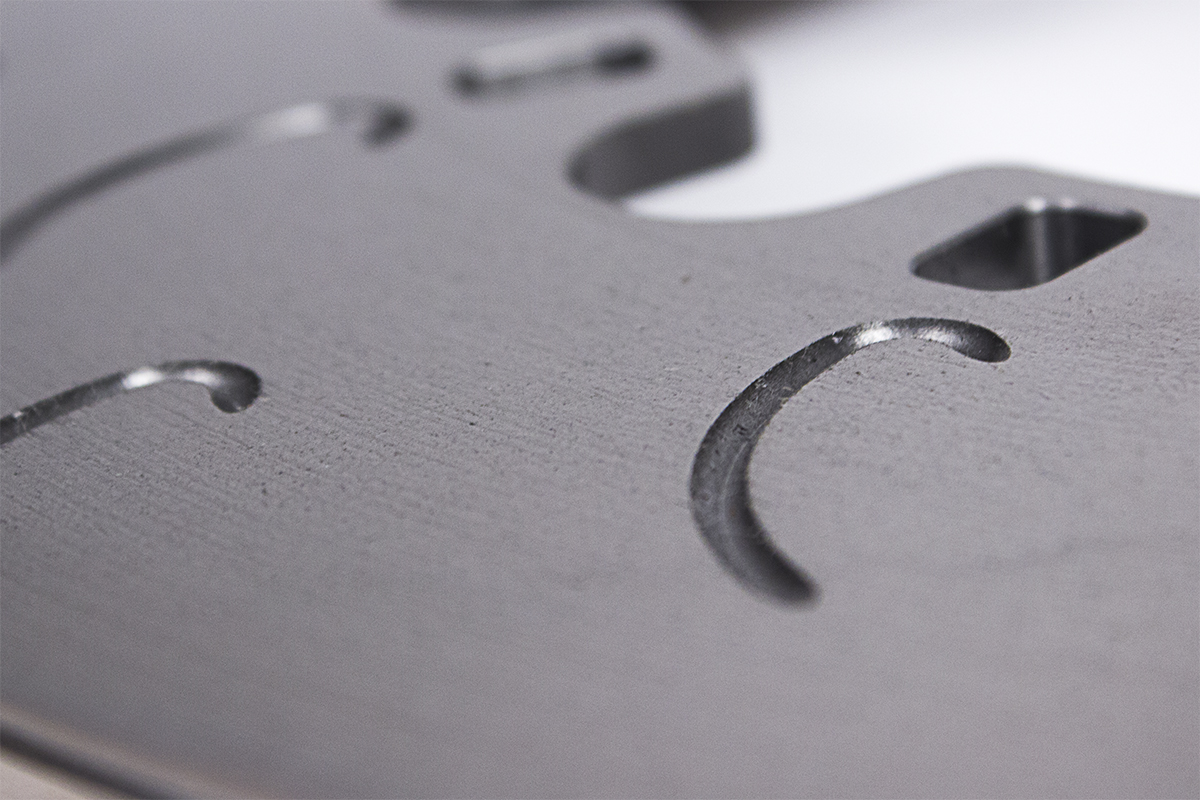
Disc Burnishing/Bedding Service
If your brake discs aren’t being properly prepared for abuse prior to flogging them on track, you’re exposing yourself to potential judder, vibration, and cracking issues. We all know that prepping your pads and discs at the track can be difficult. Doing so wastes time during the first session of the day, and it's a hassle and potentially dangerous for other drivers as you go through the procedure. Track time is expensive and tough to come by. The more time you spend behind the wheel performing an elaborate bed-in procedure, the less time you’ll spend doing hot laps. Performing the procedure on-track also limits its repeatability. You can't control what's going on around you with track conditions, other drivers, etc., and many track configurations don't really lend themselves to the constant start/stop/start required to do the job properly.
Essex is now offering a solution via our professional burnishing service. Previously reserved for our professional racing customers, we are now offering our retail customers the option of having the discs in select Competition Brake Kits pre-burnished at our factory. We burnish thousands of discs for the top racing teams each year. After countless hours of experimentation, and extensive feedback from the top drivers and teams, we can consistently squeeze the most reliable performance out of AP Racing's discs. The procedure is incredibly repeatable, as it is performed on a computer-controlled machine by experienced technicians.
The cost of our burnishing service is only $75 per disc, making it an affordable, time-saving option that will produce far more consistent and safer results than trying the procedure on your own.
Watch a brief video of our disc burnishing service here.
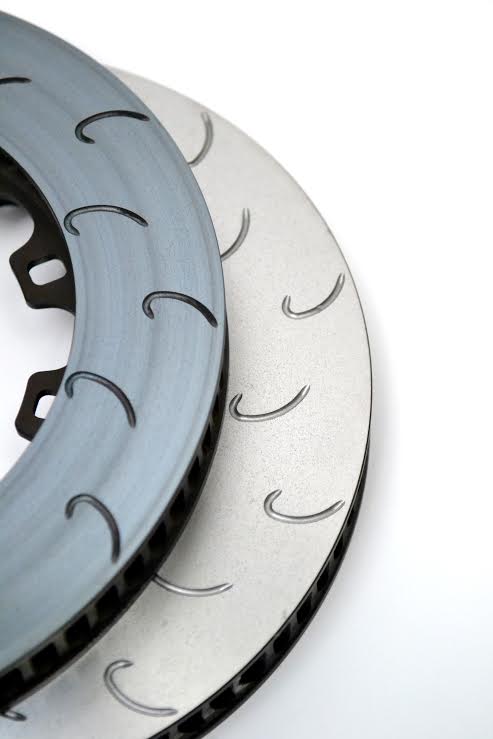
Reasonable Replacement Cost
Let's face it, no matter how good a brake disc is, it's still a consumable item. They're no different than brake pads or gasoline. You beat them up until they crack to pieces, then you throw them away. If replacement iron is too expensive, you're always driving in fear, waiting to shell out big bucks for a new set. Despite having the most expansive set of features on the market, our replacement iron rings are completely affordable.
Going to the track is expensive! Event entrance fees, hotels, fuel, and tires all add up. While you obviously want the best product available, you can't afford to pay a small fortune for something you're just going to destroy. You can buy a cheap set of $150 discs for every event, have relentless heat issues, and find yourself constantly swapping them out. When you do the math, the long-term value of the AP J Hook's is tough to beat. You'll enjoy all the benefits without breaking the bank, and you'll spend more time driving and less time wrenching.
Elite level teams choose AP Racing discs because they know the work has been done to provide the best available product at any price level. The AP J Hook is a direct derivative of AP's vast racing experience. You can buy with confidence knowing that you're getting the best product available at any price point. A note of caution however: the J Hook design is often imitated, and there are a number of lesser quality imitations on market. Before purchasing, make sure you are getting an authentic AP Racing J Hook.
Discs - Advantages Over OEM
Our AP Racing by Essex 2-piece Competition J Hooks offer our customers the following advantages over the OEM 991 GT3 PCCB discs:
- Massive increase in airflow, cooling capacity, and durability vs. OEM PCCB discs
- 15.35" x 1.25" (390mm x 32mm) 72 Vane, D66 radial depth
- Designed for: club racing, time trial, autocross, HPDE
- Ultralight, fully floating, anodized billet aluminum hat with float control/anti-rattle clips
- Available disc burnishing service ensures that your kit arrives ready to be installed and driven hard immediately
PADS - FERODO RACING FCP4665
***DESIGNED FOR USE WITH IRON DISCS ONLY, NOT FOR CARBON CERAMIC DISCS***

FRICTION COMPOUNDS
DS3.12
Released in 2019, the DS3.12 is the latest evolution in Ferodo's incredible DS line. Sports cars today have more of everything: more horsepower, more sophisticated aero, higher curb weights, and stickier tires. These attributes place serious demands on a vehicle's brake system. The Ferodo DS3.12 is the modern pad compound designed from the start to explicitly to handle those demands. Out of all the pad compounds we've ever tested, from all manufacturers, the DS3.12 shows the flattest torque curve across the broadest temperature range. That means that on every turn, on every track you drive, on every lap, your brake pedal is going to feel almost exactly the same, providing tremendous consistency and repeatability. The DS3.12 has a higher mu than Ferodo's other compounds, so not as much leg pressure is required to initiate the desired response. It is also unfadable, showing no drop in performance at any temp your brakes will ever see. In dyno testing, the DS3.12 has shown superior wear rates to the other Ferodo compounds, while remaining kind to the discs. We believe the DS3.12 will become the gold standard to which other race compounds will be compared.
DS1.11
The DS1.11 has a lower mu than the DS3.12 at all temperatures and can be characterized as a moderate mu pad vs. other endurance racing compounds. They require more pedal force than the DS3.12, and they have a slightly declining torque curve as temperatures rise. As they get hotter and you dive deeper into a turn, you may feel like you need to push a little harder on the brake pedal to elicit the same response (which is a feel many drivers actually prefer). Some drivers feel that the DS1.11 is more controllable on street tires than DS3.12 since ABS cannot be activated as easily. It will last a fairly long time vs. many other pad compounds on the market but does not last quite as long as the DS3.12. They are very gentle on discs at track temperatures when a proper pad transfer layer is maintained. The DS1.11 also has an outstanding max temp and fade resistance, just not quite as high as 3.12. We're not aware of anyone who has faded them, and most people differentiate between the DS1.11 and DS3.12 based on feel.
DS2500
Although we always recommend using a dedicated race pad for the track, the DS2500 is one of the best hybrid street/track pads on the market. It features the moderately high bite and solid fade resistance of a track pad, with the relatively low dust and noise levels of a street pad. When used as a street pad, it can produce some squeal on certain vehicle platforms. If you drive aggressively on the street, do some canyon runs, autocross, and maybe some light track duty on street tires, the DS2500 is tough to beat.
When used on track by 3,000+ lbs. cars with high horsepower and R Compound tires, DS2500 pad wear rates tend to be considerably higher vs. Ferodo Racing's other compounds. If you're looking for extended wear rates under those conditions, Essex would recommend the Ferodo DS1.11 or DS3.12.
FLUID - AP RADI-CAL™ R3 (FORMERLY BRANDED PRF)
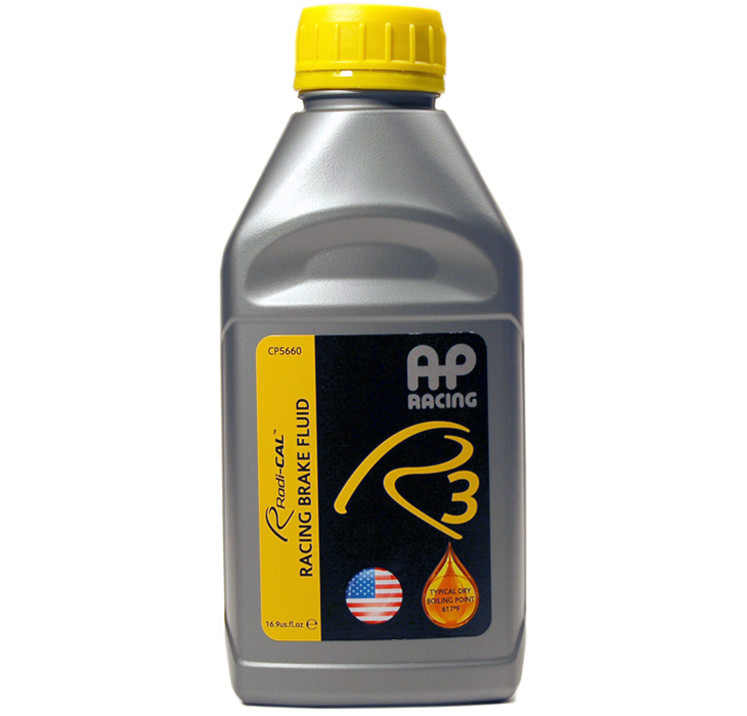
‘Typical’ New Dry Boiling Point: 325°C (617°F)
‘Wet’ E.R. (Equilibrium Reflux) Boiling Point: 195°C (383°F)
Prior to the development of AP Racing R4, R3 was the fluid of choice in many professional racing series around the world. It conforms to and exceeds FMVSS 116 DOT 4 and SAE J1703 and J1704.
STAINLESS BRAKE LINES - SPIEGLER PERFORMANCE PARTS
WHY SPIEGLER, AND NOT BRAND X?
While we're not the first to create a six line kit, we have created the best one. The quality of the Spiegler components is a cut above the competition in all regards, and you can see the superior precision of the components in the pics below. Spiegler uses 100% stainless steel fittings machined from billet, and all fittings are attached with Spiegler's exclusive stress-free torsion system. That means the lines can be twisted or turned 360 degrees after they've been attached without placing any stress on the line or fitting. The components for Spiegler lines are imported from Switzerland, and the lines are assembled and tested in Dayton Ohio. The result is a brake line of unparalleled strength, durability, and reliability. For less than the price of a set of brake pads you can have the added convenience, feel, and confidence that Essex and Spiegler bring to the table.
|
Feature |
Benefit |
|
All components manufactured in USA and Europe |
Stringent and consistent quality control |
|
Stress-free Torsion Fitting System |
Allows 360 degree rotation of banjo fitting for correct alignment and strain reduction |
|
Abrasion resistant coating/sheath |
Eliminates snagging and chafing |
|
Aircraft quality stainless steel fittings and bolts |
Superior strength, longevity, and safety |
|
Heavy gauge, tightly woven stainless steel braid |
Eliminates line swell, more consistent feel |
|
Du Pont PTFE- Teflon® lining |
Reduces line expansion and provides greater durability |
|
DOT compliant |
Quality assurance, road legal |
|
Wide range of colors |
Allows for personalization |
|
Standard and custom designs shipped in 48 hours |
No more waiting around for lines to show up |
|
Full testing battery on all parts, with lifetime warranty |
Purchase and drive with confidence |
COMPARATIVE PHOTOS: SPIEGLER VS. COMPETING PRODUCTS
In the pics below, the Spiegler lines are gray and the competitor's lines are black. Note the precision and hard edges on Spiegler's fittings and threads, as well as the torsion fittings that allow the line to be rotated 360 degrees without stress.



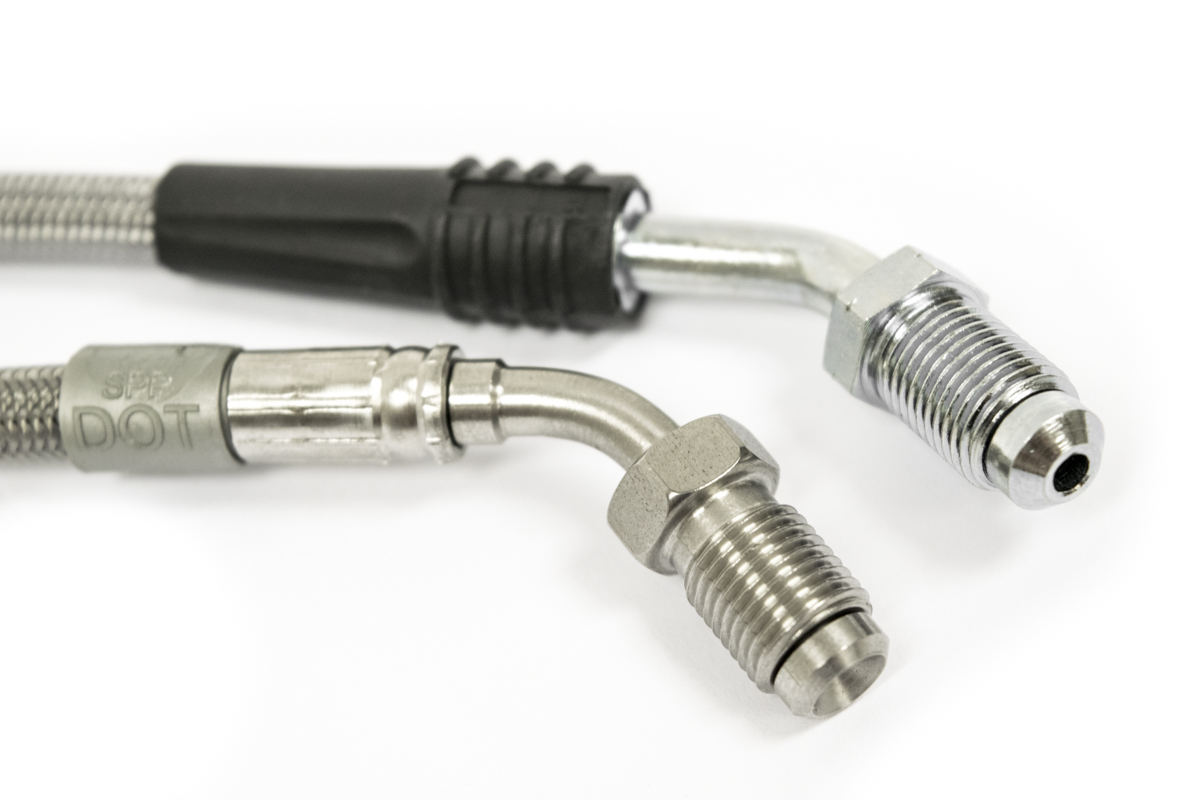
INSTALLATION
Something to keep in mind during install is that unlike just about all other brake lines, Spiegler's unique fittings are adjustable. That means no twisting or tension in the line, and you can maneuver them as needed when installing them. We created the GIF's below to show how the fittings work. The easiest way to twist them is to use the little blue plastic blocks (included with your line kit) and a pair of pliers. Then you can spin the lines to point the fitting where you need the line to go, untwist the line, etc.

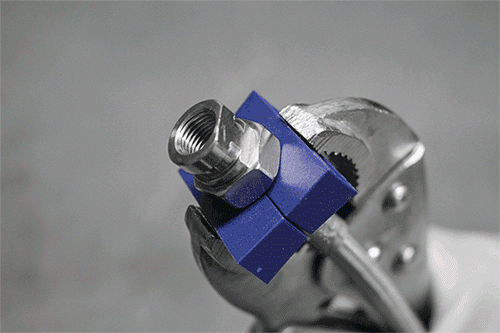
JUST HOW STRONG ARE SPIEGLER LINES?
Enough said.
